In this beginner’s guide, you will learn how to mix clean guitars. How to record, what steps to follow, and what trick to use to get great clean tones.
Mixing guitars is very important for every song. Because in most songs guitars are the main instrument. It can be a rhythm or melody instrument. And for the best results, you need a good guitar mix.
There are several guidelines to follow when mixing electric guitars. Every step is very important and adds something to the final mix.
If you are ready, let’s go deep and understand what you need to do to create great clean electric guitar mixes.
How To Mix Clean Electric Guitars
Clean electric guitars and other instruments have many things in common. Most times you use the same tools and follow somewhat similar steps.
But there are some small and important differences when you mix clean guitars.
Also, mixing clean guitar tones need a different approach than heavy guitar mixing.
When blending metal guitars, the procedure becomes more straightforward, while achieving a clean guitar tone requires a more delicate approach.
But before you start recording clean guitars, there is an important thing to do. And it’s to create two different clean guitar tones.
You need two guitar tones for double-tracking guitars. It means that you record the same part twice.
It adds depth and stereo sound to the mix. The guitar sound in the mix will be much full and rich when you double-track your guitars.
The important thing is to create two different guitar tones. They don’t have to be drastically different but both should be unique in their way. Use different guitars, mics, guitar amps, or amp settings.
The goal here is to create similar guitar tones but at the same time somewhat unique. For example, one could be mid-range driven, and another one could have enhanced high frequencies.
There are no rules. Just try to have distinct-sounding guitar tones that sit well with each other.
1. Double Track Your Guitars
The first thing in clean guitar mixing is to double-track it. You play and record the same guitar part twice with two different guitar tones, you created.
Playing must be tight and on time. You want two guitars to sound like one.
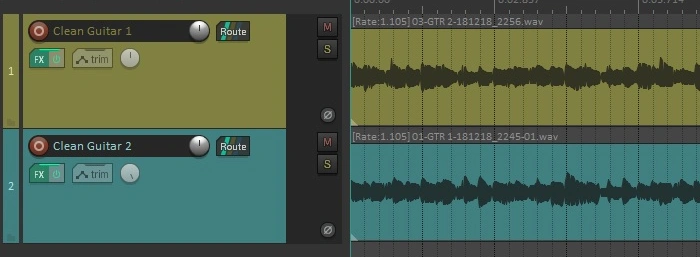
Just play the whole part with one guitar tone and record it. Then do the same with the second guitar.
Try to play perfectly and make as few mistakes as you can. Repeat the process until you have the best recording possible.
After you record both guitars and they sound perfect together, it’s time to move to the next step.
2. Volume Balance and Panning
To mix clean guitars properly, you need balance and panning. These two things are perhaps the most important. Without a good balance and panning, you can’t have a good guitar mix.
Guitars must be in balance not only with each other but with the whole mix. Guitars should not be too loud or too quiet.
They should be perfectly balanced in the mix. And it can be done with just the faders.
Just pull down both guitar faders and slowly start pushing faders up, one guitar at a time. Find the best spot where guitars sit well in the mix.
The important thing is that both guitars should be at the same volume level.
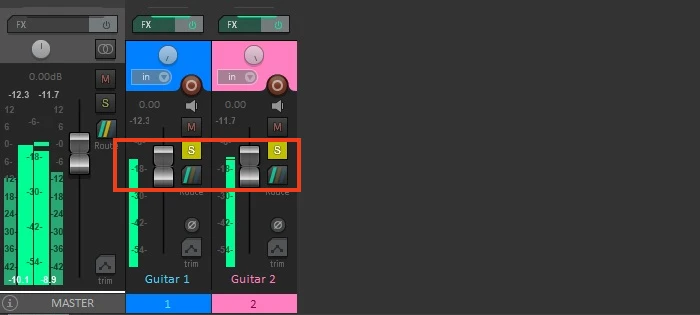
The second important thing is guitar panning. Panning is when you pan one guitar to the left and the second one to the right. This way guitars will sound bigger and fill the space in the mix.
Every DAW has a panning feature on each track. Just pan the first guitar on the left speaker and another one on the right speaker.
This way you create a stereo width and the mix will sound better. Pan them by 100%.

Now both guitars are balanced and sit well in the whole mix. Guitar volume levels are matched and guitar tracks are hard-panned on both sides. This creates width in the mix.
3. Apply High and Low Cut
It’s time for real mixing. The first tool you need to mix clean guitars is EQ and mixing starts with HPF and LPF.
In other words high cut and low cut. You are filtering and removing very high and low frequencies.
Most EQ plugins have a dedicated option for filters and use them to cut bad frequencies of clean guitars.
The frequency range to cut depends on the guitar tone. Every guitar sound is unique and requires different settings.
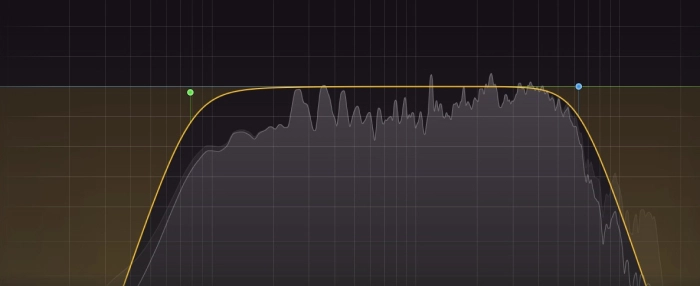
Create a filter and start moving the band across the frequency range. The goal is to cut the frequencies that the guitar doesn’t need. Very low, boomy frequencies and very high, harsh frequencies.
Don’t cut too much. Just remove the frequencies that don’t add anything to the guitar sound. It will clean the mix and also leave space for other instruments.
4. Cut and Boost Frequencies
After the low cut and high pass, it is time for a regular EQ cut and boosts to mix clean guitars properly.
First, you find the problematic frequencies and cut them. Next, find the frequency that defines the tone of the guitar and boost it.
Create an EQ band, make it narrow, and start moving it on the spectrum. Listen and find frequencies that sound boxy, muddy, or ones that make sound unpleasant. And just cut it.

Do the same for frequency boost. But this time find the frequencies that are essential for that guitar tone and boost them.
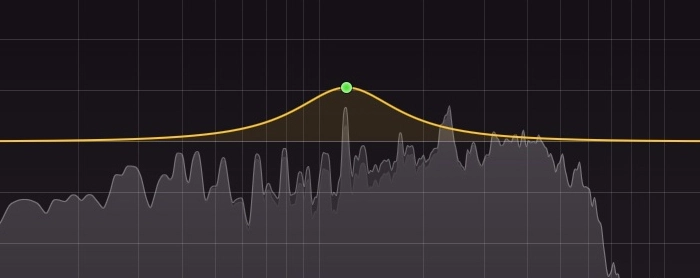
In general, for clean guitars, the frequencies to cut are in the range of 200-600Hz and 1-3kHz is a range to boost. But every guitar tone is different. Use these frequency ranges as a general guide.
Have in mind that changes shouldn’t be drastic. Don’t boost or remove too much frequency. It will cause issues and the sound will be thinner and dull. About 2 to 3dB cut and boost should be enough.
You can find out more about clean electric guitar frequencies from my EQ cheat sheet for electric guitars.
5. Use Opposite EQ Bands
To mix clean guitars even better there is one trick you can use and it is the opposite EQ band trick.
Many mixing engineers use this technique and it works for clean guitar tones most of the time. It’s not mandatory but you can implement it in your mixing.
This is how opposite EQ bands work. You find the best-sounding frequency for one guitar and boost it. On the second guitar, you cut the same frequency. And you do the same for the second guitar.

For example, you choose 250Hz and 1750Hz for both guitars. On the first guitar, you boost 250Hz and cut 1750Hz, and then do the opposite cut and boost. This way you will have different cuts and boosts of the same frequency for both guitars.
This technique blends two sounds perfectly because you cut a frequency on one guitar, and the second guitar fills that gap. This way guitar track sounds full.
This is a very good technique to fit two clean guitar tones together. Just find the best-sounding frequencies for both guitars and boost them.
6. Compress Guitars
After EQ guitar tracks need compression. Clean guitars are very dynamic and need compression to make sound consistent and even throughout the whole song.
Use any compressor plugin you like, insert it on both guitar tracks, and add compression.
The amount of compression heavily depends on the guitar tone. The goal here is to make the sound consistent but retain as much dynamic as possible.
Too much compression could wipe out dynamics and make the sound very dull. Just try to get the highest peaks and compress them.
Set the threshold, start with the 4:1 ratio, and see what impact it has on the guitar sound.
Compress both clean guitars separately and don’t forget to control input and output volume after compression. Output just be the same as the input.
7. Send Guitars To Bus Track
To mix clean guitars further you need to create a guitar bus track and send both guitars to that track.
This gives you the ability to control two guitars with one track. You can add plugins, control volume, etc.
Every DAW has its process of bus track creation but here is how it goes.
You create an auxiliary track and send guitar sound to that track. Now the signal from both guitars goes to this track and then it goes to the master bus.
As long as you have two guitars connected to one track, now you can apply EQ and compression again to both guitars at the same time.
Learn more about the audio bus track here.
8. Small EQ and Compressor Changes
Apply EQ and compressor to the guitar bus track and start tweaking. This time mixing should be very subtle.
Add HPF and LPF to remove unnecessary frequencies again. Apply small EQ bands here and there.
Finally, add compression and make the sound even more consistent.
Remember that at this stage changes must be subtle and minimal. No drastic changes are needed.
A couple of decibel cuts and boosted and about 2:1 ratio compression with a moderate threshold.
9. Add Reverb On Guitars
And the final thing to do to mix clean guitars perfectly is to add reverb or any other effect to the sound and reverb is the most important.
It will give clean guitars more space and breathing air and the sound will be more natural.
But don’t apply reverb on the guitar track itself. There is a special way to apply reverb on guitars or any other musical instrument.
This method works when you apply reverb on drums too.
Create an empty track as you did for the guitar bus track. Insert reverb on the new track and send the signal from the guitar bus to the new track.
Now the signal from the guitar bus goes to two tracks – a master bus and a reverb track. And from the reverb track, it goes to the master bus.
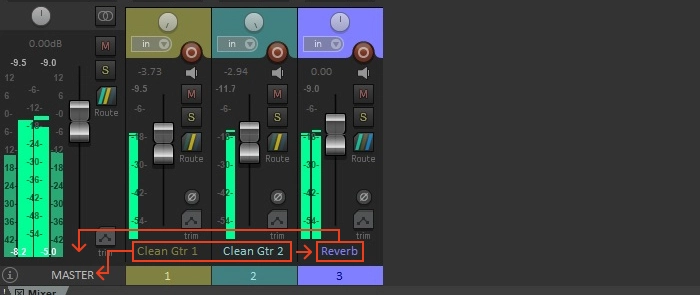
The reason why you need a separate track for reverb is to blend it with the dry guitar track.
The main guitar sound source is the guitar bus track and then you blend the reverb track to add space and air to the sound.
Tweak reverb settings and create a good guitar sound with the reverb. Turn down the reverb track fader to mute it.
And then start playing the mix and slowly start turning up the reverb track fader to blend it.
Do this until you are satisfied with the sound. What you want to do is to have your main guitar sound but also hear some reverb. This will make the guitar sound more natural and alive.
Conclusion
To mix clean guitars you need to be delicate and pay attention to every detail. First, you need to create good clean guitar tones, record them well, and apply these mixing techniques to get a good result. Balance the sound in the mix, and apply EQ and compression to make guitars sit well in the mix.
Finally, add reverb to make the guitar sound more natural and airy. Just remember – always create a separate track for reverb and blend it with the main track.
